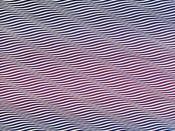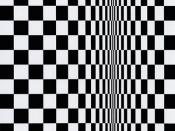Bridget Riley was born in 1931 at Norwood, London, and the daughter of a businessman. Her childhood was spent in Cornwall and Lincolnshire. She studied at Goldsmiths College from 1949 to 1952, and at the Royal College of Art from 1952 to 1955. Riley has exhibited widely since her first solo show in 1962. Among numerous exhibitions, she was included in the 1968 Venice Biennial where she won the International Prize for painting. Riley began painting figure subjects in a semi-impressionist manner, then changed to the Neo-Impressionist technique of Pointillism around 1958, mainly producing landscapes. The same year she was deeply impressed by the large Jackson Pollock exhibition at the Whitechapel Art Gallery in London.
English painter and designer, the leading British exponent of Op Art, whose interest in optical effects came in part from her study of Seurat's technique of pointillism. In 1960, Riley working initially in black and white, she evolved a style in which she explored the dynamic effects of optical phenomena.
These so-called "Op-art" pieces, such as "Fall", 1963, produce a disorienting physical effect on the eye. Her work shows a complete mastery of the effects characteristic of Op art, particularly subtle variations in size, shape or placement of serialized units in an all-over pattern. It is often on a large scale and she frequently makes use of assistants for the actual execution. She turned to colour in 1966. By this time she had attracted international attention (one of her paintings was used for the cover to the catalogue of the exhibition ÃÂThe Responsive EyeÃÂ at the Museum of Modern Art, New York, in 1965, the exhibition that gave currency to the term ÃÂOp artÃÂ), and the seal was set on her reputation when she won the International Painting Prize at the Venice Biennale...


